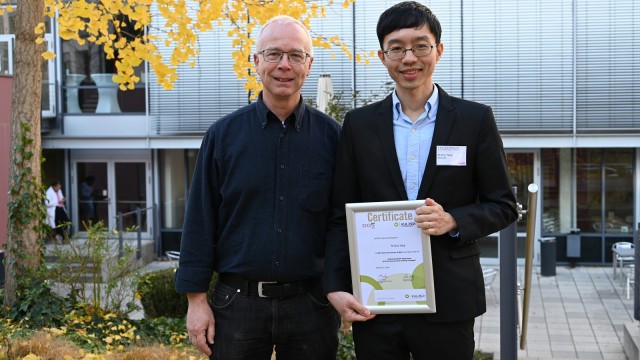Contact Kulzer International
Innovation at the forefront: pioneering work in dental restorations
In the field of restorative dentistry, the project InnoPrintIve: Innovative Printing Initiative led by Po-Chun Tseng of the Ludwig-Maximilians-University in Munich, Germany, has caught the attention of the dental community and received the prestigious Kulzer Start Grant from the DGR²Z (German Society for Restorative and Regenerative Dentistry). What is behind this project that can produce high-fidelity composite restorations printed with Direct Ink Writing technology and has the potential to disrupt the traditional practice of restorative dentistry?

Unlocking the potential of 3D printing
Under the mentorship of Prof. Dr. Karl-Heinz Kunzelmann, Tseng is not only using 3D printing technology, but also redefining its application in dentistry. “The timing of the grant was perfect because it allowed us to explore and develop ideas that could significantly improve dental care,” says Tseng of the project’s inception and goals. Tseng continues: “We have been able to produce restorations that offer both excellent accuracy and robust mechanical properties through the extrusion of resin composites. This technology has the potential to expand access to indirect restorations and transform dental procedures and patient care.”

Catalyzing innovation in dentistry
The agility facilitated by the DGR²Z Kulzer Start Grant, Professor Kunzelmann points out, allows the team to bypass traditional barriers. “It enables the rapid implementation of novel solutions and frees us from the lengthy approval processes that often stifle innovation,” he notes. This flexibility is critical to overcoming the project’s main technical challenge: the handling of highly viscous materials for 3D printing applications.
Tackling technical challenges with innovative solutions
Reconstructing multiple teeth directly in the mouth is both strenuous and time-consuming, requiring almost artistic skill from dentists, while lab-made occlusal veneers can be prohibitively expensive. The novel 3D printer offers an efficient and accurate alternative, capable of printing full-coverage fillings with less than 35 µm deviation from the design in just 15-20 minutes at the dentist’s office. Furthermore, the innovative printing process constitutes a significant step in dental sustainability through minimizing material waste and eliminating the need for energy-intensive post-processing.
The project’s breakthrough lies in its approach to handling composite materials, which have traditionally presented challenges due to their high viscosity. “By developing a system that can effectively handle these materials, we’re setting new standards for indirect dental restorations,” explains Tseng. This innovation could dramatically streamline the restoration process, making it faster and less stressful for both dentists and patients. In addition, the use of open source and open hardware technologies keeps costs low, making this advanced 3D printer a viable option for resource-constrained dental practices.

The way forward: refining the technology for clinical use
Despite the project’s significant achievements, the path from prototype to clinical application is full of challenges that Tseng is eager to tackle. “We are in the process of enhancing the printer’s capabilities and exploring partnerships for its further development,” says Tseng, outlining the next steps in bringing this innovative technology to dental practices worldwide.
Fostering a culture of innovation in dentistry
The DGR²Z Kulzer Start Grant not only acknowledges Tseng and Kunzelmann’s innovative approach, but also encourages further progress. “It is a remarkable recognition that increases the visibility of our project and fosters industry connections,” says Tseng, optimistic about the impact on dental care.
At this point, Professor Kunzelmann interjects with a reflection on their collaboration: “I am grateful to have met Mr. Tseng. He has done a truly outstanding job. Achieving deviations of less than 35 µm from the computer-generated ideal shape is no small feat. His contribution to the field of dental restorations is commendable.”
Po-Chun Tseng emphasizes the value of the Kulzer Grant for the scientific community: “The recognition is fantastic and opens up new opportunities for the project and personal career prospects. It encourages creativity and innovation and helps to make a name for oneself in the community.”
An online repository was created for the InnoPrintIve project to facilitate scientific exchange and innovation. Further information can be found here.
Leave a comment

-
Manager Corporate Communications
-
Matthias Brehmke
- More blog posts


